A gate valve is a type of valve used to control the flow of a fluid (gaseous or liquid) through a pipe. The key characteristics of a gate valve are:
- Gate-like Component: As its name suggests, a gate valve uses a gate-like component to control flow. The gate is typically a flat disc or a wedge that slides up and down perpendicular to the flow.
- Operation: Manually operated gate valves are operated by turning a handle or a wheel, which moves the gate up or down via a threaded stem. Typically, when the gate is lifted, it allows fluid to pass through. When the gate is lowered, it blocks the flow.
- Use Cases: Gate valves are typically used in applications where a straight-line flow of fluid and minimum restriction is desired. Gate valves are used in on/off applications where the valve is either completely open or completely closed.
- Not for Throttling: These valves are not suitable for throttling (regulating flow by partially opening and closing) because accelerated flow through the partially open gate causes damage to the gate and sealing components.
- Leakage and Wear: When fully opened, the gate is completely removed from the flow, creating minimal pressure drop across the valve.
- Design Variants: Gate valves can come in various designs. With non-rising stem designs, the gate travels up and down the stem as the stem is rotated. Rising stem valves have the gate and stem moving together as the stem is rotated.
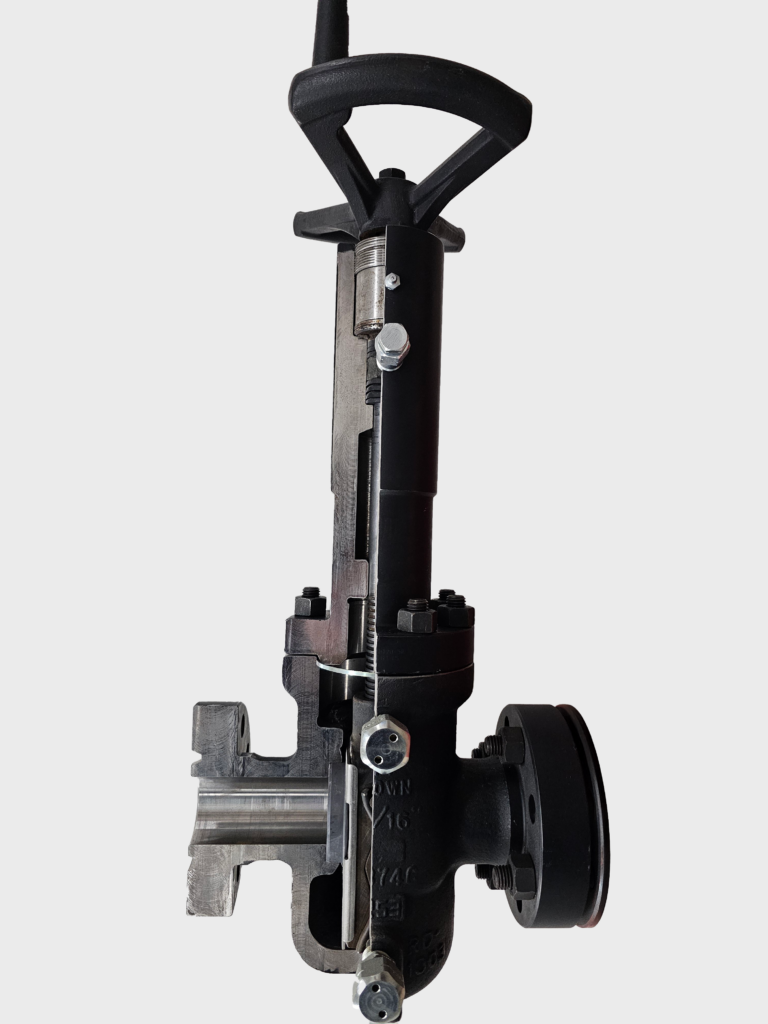
A Stream-Flo AV Gate Valve that has been cut to show the internal workings for educational purposes.
Properties of Gate Valves
Gate valves are widely used in the oil and gas industry due to several key advantages they offer, which make them particularly well-suited to the requirements of the energy sector:
- Ability to Handle High Pressures and Temperatures: The oil and gas industry often involves high-pressure and high-temperature environments. Gate valves are robust and can be designed to withstand these extreme conditions, making them suitable for critical applications in upstream, midstream, and downstream processes.
- Minimal Pressure Drop: When fully open, a gate valve provides a straight path for the flow of fluid, resulting in minimal pressure drop across the valve. The open gate provides full bore access to the wellhead for the passage of tools and downhole equipment.
- Tight Sealing: Gate valves offer a tight seal when closed, which is essential for preventing leaks. This is particularly important in the oil and gas industry, where leaks can have serious safety, environmental, and economic implications.
- Low Turbulence Flow: The design of gate valves allows for a smooth and uninterrupted flow when the valve is fully open, reducing the risk of turbulence which can be detrimental in certain pipeline applications.
- Suitability for Slurry and Viscous Fluids: The full-bore design of gate valves makes them suitable for handling slurry and viscous fluids, which are often encountered in oil and gas operations.
- Isolation Purposes: Gate valves are ideal for on/off control of the fluid flow, which is necessary for isolation purposes at the wellhead during maintenance, emergencies, or other operational requirements in oil and gas applications.
- Durability and Longevity: These valves are designed for longevity and durability, which is essential in the oil and gas industry where equipment needs to operate reliably over long periods under harsh conditions.
- Adaptability to Different Materials and Coatings: Gate valves can be made from a variety of materials, including carbon steel, stainless steel, and alloy steels, which can be selected based on the specific application. They can also be coated or treated to resist corrosion, which is a common challenge in the oil and gas industry.
- Compliance with Industry Standards: Gate valves used in the oil and gas industry are manufactured and tested according to stringent industry standards, ensuring safety, reliability, and performance.
Given these characteristics, gate valves are often the preferred choice for many applications within the oil and gas industry, including drilling operations, pipeline systems, refining processes, and petrochemical plants. However, it is important to select the right type of gate valve based on specific application requirements, such as the nature of the fluid, pressure and temperature conditions, and the operational environment.
Used with wellheads?
Yes, gate valves are commonly used on wellheads in the oil and gas industry. A wellhead is the component at the surface of an oil or gas well that provides the structural and pressure-containing interface for the drilling and production equipment. Gate valves play a critical role in these setups for several reasons:
- Control of Flow: Gate valves are used to control the flow of oil and gas from the well. They can be fully opened or closed to start or stop the flow, which is essential for the safe and efficient operation of the well.
- High-Pressure Environments: Wellheads often operate under high-pressure conditions. Gate valves are designed to withstand these high pressures, making them suitable for this application.
- Emergency Shut-off: In the event of an emergency, such as a blowout, gate valves can be used to quickly shut off the flow of oil or gas from the well, helping to prevent accidents and environmental damage.
- Isolation for Maintenance and Repairs: Gate valves can isolate sections of the wellhead for maintenance, repairs, or other operations. This isolation capability is crucial for ensuring safety and operational efficiency.
- Compatibility with Other Wellhead Equipment: Gate valves are designed to provide full bore access to the wellbore. The valves are compatible with other wellhead components, such as casings, tubing, and trees (the assembly of valves, spools, and fittings used to control the flow of oil and gas).
- Durability and Reliability: The robust design of gate valves ensures they can withstand the harsh conditions often encountered in wellhead operations, including exposure to corrosive fluids and abrasive materials.
- Compliance with Standards: Gate valves used in wellhead applications are typically manufactured and tested according to industry standards (like API 6A for wellhead and tree equipment) to ensure safety, reliability, and performance.
- Manual and Automated Operations: Gate valves can be operated manually or fitted with actuators for automated control, depending on the requirements of the wellhead system.
In summary, gate valves are a vital component in wellhead assemblies due to their ability to handle high pressures, provide reliable flow control, and offer a secure means of isolation and emergency shut-off in oil and gas extraction operations. Their selection and maintenance are key to the safe and efficient management of wellheads.
Operation
A gate valve operates using a simple mechanism to control the flow of fluids (liquids or gases). Here’s an outline of how they work:
- Basic Structure: The main components of a gate valve are the body, the gate, the stem, and the handwheel or actuator.
- The Gate: The gate is a flat, rectangular, or wedge-shaped component that slides up and down to control the flow of the fluid. When the gate is lowered into the path of the fluid, it stops the flow. When raised, it allows the fluid to pass through.
- Operating the Valve:
- Manual Operation: In manual gate valves, a handwheel or a handle is attached to the stem. When you turn the handwheel, it rotates the threaded stem, which is connected to the gate.
- Automatic Operation: In automated systems, an actuator (which could be pneumatic, hydraulic, or electric) is used to move the gate.
- Stem Movement:
- Non-Rising Stem: In non-rising stem valves, the stem remains at the same height regardless of the valve position. The gate travels along the stem thread as the stem is rotated to open or close the valve. Some valves are equipped with optional accessories such as a pointer or indicator to show the position of the gate.
- Rising Stem: For valves with a rising stem, the stem rises as you turn the handwheel counter-clockwise, lifting the gate away from the valve seat to open the valve. Turning the handwheel clockwise lowers the stem and gate, closing the valve.
- Flow Control:
- Fully Open or Closed Position: Gate valves are designed for on/off services. They are prone to damage when not fully opened or fully closed.
- Not for Throttling: Using a gate valve to partially open or close (throttle) the flow can lead to damage. High fluid velocity of throttled flow can damage the valve with catastrophic results.
- Sealing the Flow: When the gate valve is closed, the gate comes down and sits tightly against the valve seat, creating a seal that prevents fluid from passing through.
Gate valves are effective in applications where you need either a free flow or no flow at all. Their design is not suitable for fine control of the flow. They are used in situations where the valve will remain in either the fully open or fully closed position during its operational life.
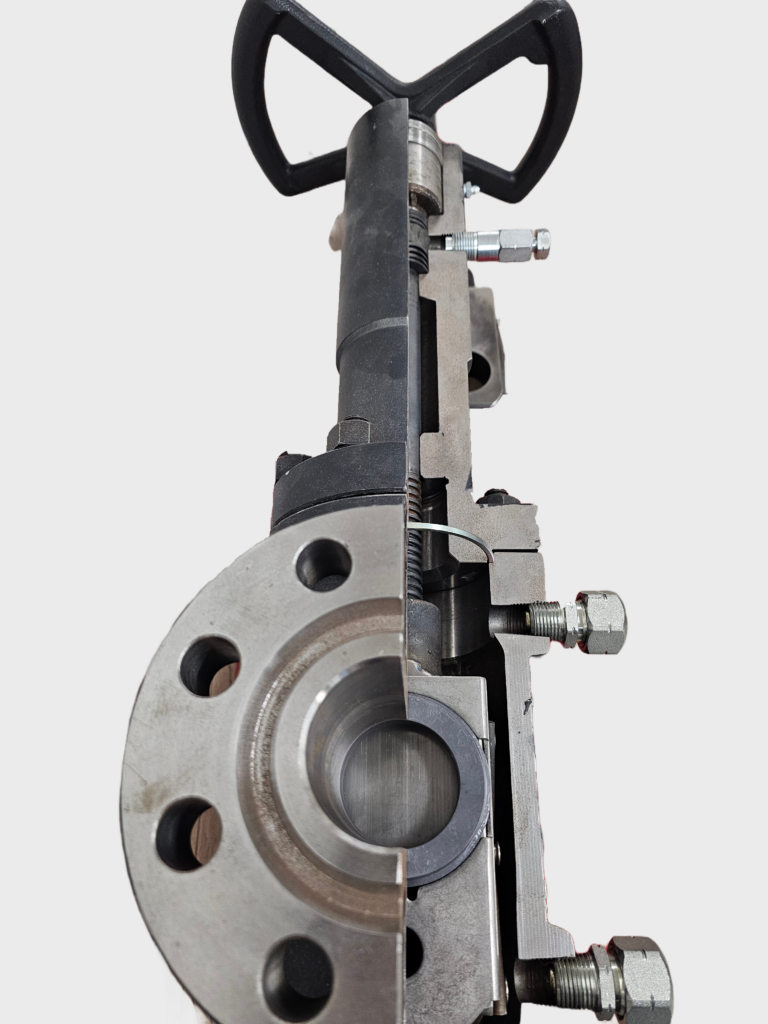
This cross section of a Stream-Flo gate valve shows the gate in the fully closed position which would be used to isolate flow from the wellhead. It is important to remember that gate valves are designed to be used either fully open or fully closed, and not to be used for throttling. Choke valves, such as the ones made by Master Flo, are designed and suited for controlling and regulating the flow of gas or liquids to a precise level.
Component Breakdown
A gate valve is composed of several key components, each playing a crucial role in its operation. The main components are:
- Body: The body forms the main structure of the gate valve and contains the internal parts. It is typically made from durable materials like cast or forged alloy steel, or other metals, depending on the application.
- Bonnet: The bonnet is attached to the body and provides a leak-proof closure for the valve body. The bonnet is bolted to the valve body.
- Gate: The gate is the component that moves up and down to control the flow of the fluid.
- Stem: The stem connects the gate to the external control mechanism (like a handwheel for manually operated valves ). It translates the rotational motion of the handwheel into the linear motion needed to move the gate. For actuated valves, the linear motion of the actuator directly moves the gate attached to the stem.
- Handwheel or Actuator: This is the component used to operate the valve. A handwheel is used for manual operation, while an actuator (which could be pneumatic, hydraulic, or electric) is used for automated control.
- Seat: The seat provides a sealing surface for the gate. When the valve is closed, the gate presses against the seat to create a tight seal. Seats can be integral with the valve body or can be separate components that are pressed, into the valve body.
- Stem Nut: The stem nut, located inside the bonnet, converts the rotational motion of the handwheel into linear motion of the stem and gate.
- Packing: Packing material is used to ensure a tight seal around the stem and prevent fluid leakage. It is usually placed in a packing gland.
- Packing Gland: This component compresses the packing to provide an effective seal around the stem.
- Bonnet Gasket: Bonnet gaskets are used to ensure a tight seal between the valve body and bonnet.
- Yoke: In some designs, particularly with rising stem gate valves, a yoke is used to support the stem and actuator mechanism.
- Backseat: A backseat is a feature in some gate valves that allows for replacement of stem packing while the valve is under pressure.
These components work together to allow the gate valve to effectively control the flow of fluids in a piping system. The design and material of each component can vary depending on the specific application and the properties of the fluid being controlled (like temperature, pressure, and corrosiveness).
Sizing Ranges
Yes, gate valves come in a wide range of sizes to accommodate various piping systems and flow requirements. The size is typically determined by the diameter of the pipe in which it is installed, and it can vary significantly based on the application. Here are some key points regarding the sizing of gate valves:
- Nominal Size Range: Gate valves are available in a broad range of sizes, from small valves (less than an inch in diameter) for home plumbing systems, to very large valves (up to several feet in diameter) used in major industrial and municipal applications.
- Pipe Size Compatibility: The size of a gate valve is usually expressed in terms of nominal pipe size (NPS) or diameter nominal (DN). This sizing is designed to match the standard sizes of pipes.
- Industry Standards: The sizing and dimensions of gate valves are often standardized according to industry norms and standards, such as those set by the American Petroleum Institute (API), the American National Standards Institute (ANSI), the International Organization for Standardization (ISO), or other national and international bodies.
- Pressure Rating: Along with size, gate valves are also rated for pressure. The pressure rating, often indicated as Class (like Class 150, Class 300, etc.), determines the maximum pressure the valve can handle at a certain temperature.
- End Connections: The end connections are the parts that connect to the piping, also vary in size and type. Common types include flanged ends, threaded ends, and butt-weld ends, and they must be compatible with the pipe’s connection type.
- Application-Specific Designs: In specialized applications, there may be custom-sizing designed to fit specific requirements, such as in certain types of machinery, specialized industrial processes, or unique piping configurations.
Due to the wide variety of sizes available, it’s crucial to select the right size for a specific application, considering factors like the size of the pipe, the flow rate required, and the pressure of the system. Using an appropriately size ensures efficient operation, minimizes pressure drops, and reduces the risk of damage or wear.
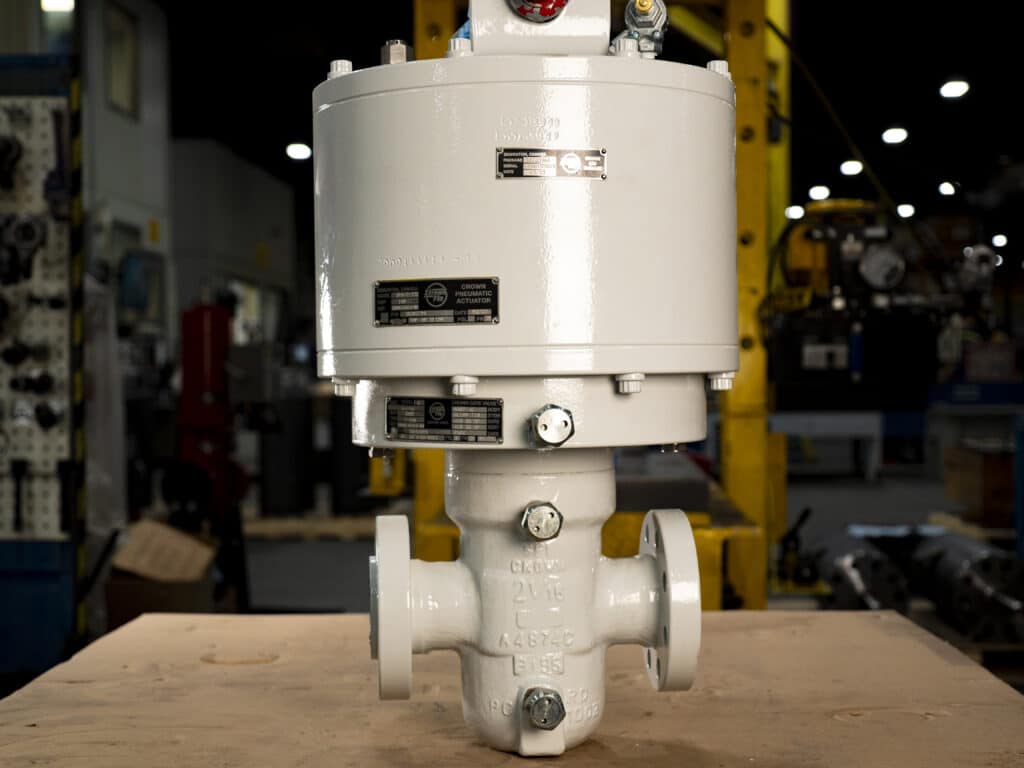
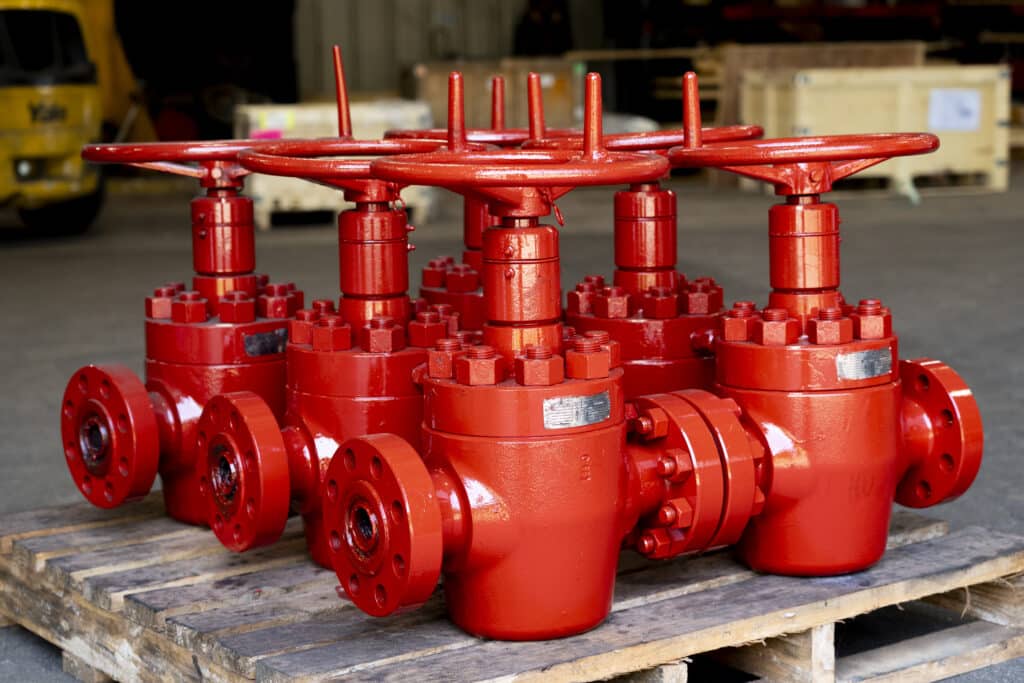
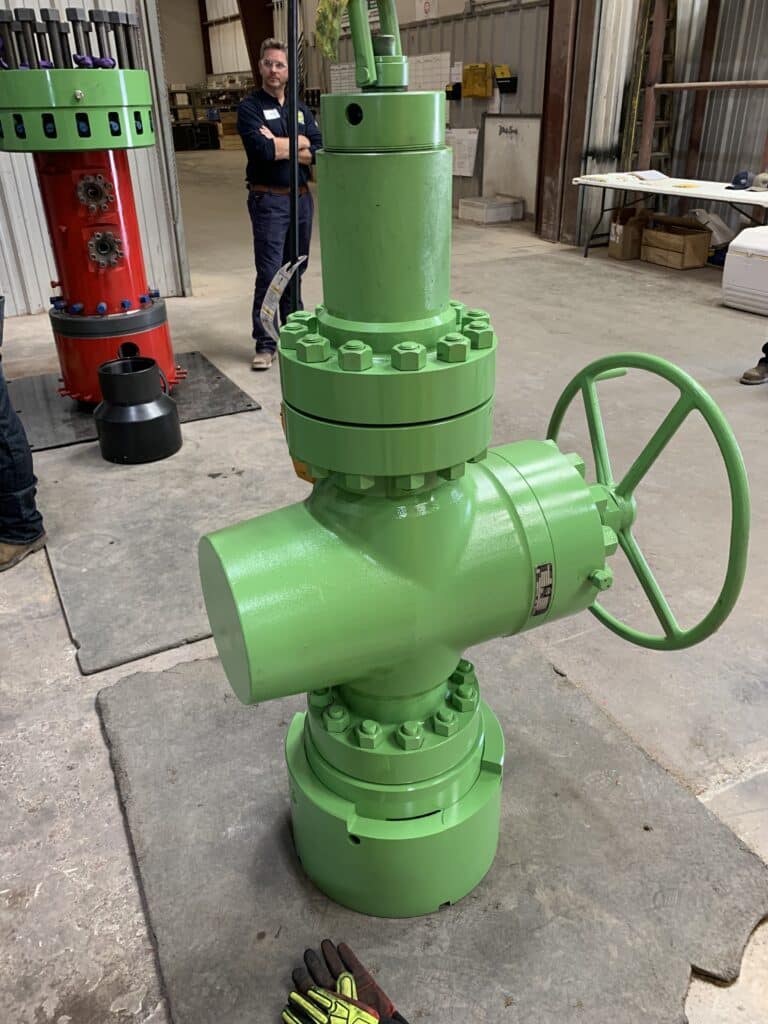
From small to big, different sized Stream-Flo gate valves are seen to illustrate the various sizes these isolation valves come in.
Are there different pressure ratings?
Yes, gate valves used in the oil and gas industry come with different pressure ratings to suit the varied and often high-pressure conditions encountered in these sectors. The pressure rating of a gate valve indicates the maximum pressure at which the valve can safely operate. Here are some key aspects of pressure ratings for oil and gas gate valves:
- Pressure Rating Standards: Pressure ratings for gate valves in the oil and gas industry are typically standardized. The American Petroleum Institute (API), American National Standards Institute (ANSI), and International Organization for Standardization (ISO) are some of the organizations that define these standards. Common standards include API 6A for wellhead valve equipment, API 600 for bolted bonnet steel gate valves, API 6D for pipeline valves, and ANSI/ASME B16.34 for valve design.
- Rating Classifications: The pressure ratings are often designated by classes or series. For example, ANSI/ASME valve ratings might include Class 150, Class 300, Class 600, Class 900, Class 1500, and Class 2500, where the number typically indicates the maximum pressure in pounds per square inch (psi) that the valve can handle at a reference temperature (usually 100°F).
- High-Pressure Applications: In the oil and gas industry, where high pressures are common, gate valves with higher pressure ratings are frequently used. For instance, Class 1500 or Class 2500 valves might be used in high-pressure gas transmission pipelines.
- Material and Design Influence: The pressure rating of a gate valve also depends on the materials used and the design of the valve. Stronger materials and more robust designs are required for higher pressure ratings.
- Temperature Factor: The pressure rating is also influenced by temperature. As the operating temperature increases, the maximum allowable pressure typically decreases. Manufacturers usually provide pressure-temperature charts for their valves.
- Special Ratings for Sour Service: In oil and gas extraction, valves might be exposed to ‘sour service’ conditions (presence of hydrogen sulfide, H2S). Special standards like NACE MR0175/ISO 15156 specify requirements for materials and designs suitable for these corrosive environments.
- Custom Ratings: In some specialized cases, custom-designed gate valves with unique pressure ratings are manufactured to meet specific requirements of a particular application in the oil and gas sector.
Choosing the correct pressure rating in oil and gas applications is crucial for safety, performance, and equipment longevity. It’s essential to consider both the maximum operating pressure and the temperature range of the application when selecting a gate valve.
Is there a certification process or governing body for Gate Valves?
Yes, there is a certification process and several governing bodies that set standards and provide certifications for gate valves used in the oil and gas industry. These certifications ensure that the valves meet specific safety, quality, and performance requirements. Key organizations and aspects of certification include:
- American Petroleum Institute (API): API is one of the primary governing bodies in the oil and gas industry. It provides specifications, standards, and certifications for oil and gas equipment, including gate valves. Key API standards include API 600 (Bolted Bonnet Steel Gate Valves), API 6D (Pipeline and Piping Valves), and API 6A (Valves for Wellhead and Christmas Tree Equipment).
- American National Standards Institute (ANSI): ANSI, in conjunction with the American Society of Mechanical Engineers (ASME), establishes standards for industrial valves, including gate valves. The ANSI/ASME B16 series of standards covers aspects like design, dimensions, and testing of valves.
- International Organization for Standardization (ISO): ISO provides international standards, including those relevant to oil and gas. ISO 5208, for instance, is related to industrial valve testing.
- NACE International: Formerly known as the National Association of Corrosion Engineers, NACE sets standards for materials used in environments with high corrosion risk, like oil and gas extraction sites. NACE MR0175/ISO 15156 is a critical standard for materials resistant to sulfide stress cracking in sour oilfield environments.
- Certification Process: The certification process generally involves a series of inspections, tests, and quality assurance steps conducted by the manufacturer and sometimes independent third-party organizations. This process includes material inspection, design verification, manufacturing process checks, and performance tests such as pressure and leak tests.
- CE Marking (for Europe): In Europe, valves may need to comply with the Pressure Equipment Directive (PED) and carry the CE mark, indicating they meet EU safety, health, and environmental protection requirements.
- Other Regional and National Standards: Depending on the region and application, other standards and certifications may apply. For instance, valves used in the European Union, Canada, or Russia might need to meet additional or different regulatory requirements.
- Quality Management Systems: Manufacturers for the oil and gas industry often implement quality management systems like ISO 9001 to ensure consistent product quality and adherence to industry standards.
Selecting gate valves that are certified and compliant with these standards is crucial for ensuring safety, reliability, and efficiency in the demanding environments of the oil and gas industry. This adherence to standards is not just a matter of regulatory compliance but also a key factor in ensuring the operational integrity and longevity of the equipment.
